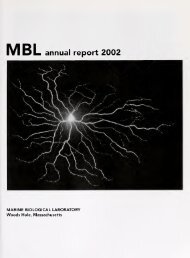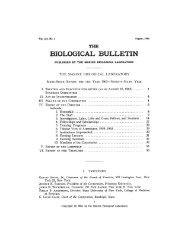46 researchlaboratory of aquatic biomedicineSENIOR SCIENTISTCarol L. ReinischASSISTANT RESEARCHSCIENTISTRachel CoxPOSTDOCTORALSCIENTISTJill KreilingVISITING INVESTIGATORRaymond Stephens,Boston <strong>University</strong>Our goal is to use marine animals as biomedical models. Wehave explored mechanisms of neurotoxicity using surf clamembryos (Spisula solidissima). We have discovered that a mixtureof chemicals found in polluted wells in Brick, New Jersey, causesan increase in an enzyme critical for neuronal development. Byfocusing on the p53 gene family, we have proven that p73 (notp53) may be exclusively expressed by Spisula neurons. Whetheror not p73 is a molecular target of environmental neurotoxinsremains to be determined.In our second model, we define the impact of environmentalcontaminants on a leukemia developed by blue mussels (Mytilusedulis). In collaboration with Environment Canada, we havediscovered that industrial chemicals plus untreated human wasteresults in much higher levels of leukemia throughout a pollutedharbor in Pictou, Nova Scotia. We have also discovered leukemiain Mytilus trossolus in Vancouver Harbor, British Columbia.We use both molecular and cellular assays to determine thelevel of toxicity and carcinogenicity in these molluscan species.Currently we are examining mechanisms of action using zebrafishembryos where more powerful and accurate probes are availablefor our research.PublicationsDewilde, S; Ebner, B;Vinck, E; Gilany, K;Hankeln, T; Burmester,T; Kreiling, J; Reinisch,C; Vanfleteren, JR;Kiger, L; Marden, MC;Hundahl, C; Fago,A; Van Doorslaer, S;Moens, L. 2006. Thenerve hemoglobin of thebivalve mollusc Spisulasolidissima: Molecularcloning, ligand bindingstudies, and phyogeneticanalysis. J Biol Chem 281:5364-5372.Muttray, AF; Cox, RL;St-Jean, S; van Poppelen,P; Reinisch, CL; Baldwin,SA. 2005. Identificationand phylogeneticcomparison of p53 intwo distinct musselspecies (Mytilus).Comp. Biochem. Physiol.C140(2): 237-250.St-Jean, SD; Stephens,RE; Courtenay, SC;Reinisch, CL. 2005.Detecting p53 familyproteins in haemocyticleukemia cells of Mytilusedulis from PictouHarbour, Nova Scotia,Canada. Can. J. FisheriesAquatic Sci. 62(9): 2055-2066.
esearch 47ADJUNCT SCIENTISTSBarbara C. FurieBruce FurieLeisa StenbergVISITING SCIENTISTJohan Stenflo, <strong>University</strong>of Lund, SwedenASSISTANT RESEARCHSCIENTISTMark BrownPublicationBrown, MA; Begley, GS;Czerwiec, E; Stenberg,LM; Stenflo, J; Jacobs, M;Kalume, DE; Roepstorff, P;Furie, BC; Furie, B. 2005.Precursors of novel Glacontainingconotoxinscontain a carboxy-terminalrecognition site thatdirects γ−carboxylation.Biochemistry 44: 9150-9159.laboratory of barbara furie and bruce furieγ−Carboxyglutamic acid is a calcium-binding amino acid that isfound in the conotoxins of the cone snail, Conus. This laboratoryinvestigates the vitamin K-dependent biosynthesis of this aminoacid in Conus and other marine invertebrates. This satellitelaboratory relates closely to the main laboratory, the Center forHemostasis and Thrombosis, at Harvard Medical School in Boston.The marine cone snail is the sole invertebrate known to containthe vitamin K-dependent amino acid, γ−carboxyglutamic acid(Gla). This amino acid is found in conotoxins within its venom.During the past year, we have proven that γ−carboxylation is aposttranslational process and not a cotranslational process. Novelconotoxins containing γ−carboxyglutamicacid were cloned, and found to have acarboxylation recognition site downstreamof the target glutamic acids instead of theusual upstream site within the codingregion of the propeptide.We have cloned and compared theγ−glutamyl carboxylase from vertebratesand invertebrates—the enzyme required tosynthesize γ-carboxyglutamic acid—anddemonstrated marked sequence similaritydespite evolutionary divergence over500 million years ago. These resultsdemonstrate the vitamin K-dependentbiosynthesis of Gla is a highly conserved function in the animalkingdom. To identify novel Gla containing proteins conservedin animal species, we are identifying novel vitamin K-dependentproteins in invertebrates and hemichordates.
- Page 1 and 2: MBL7 MBL StreetNon-profit Org.U.S.
- Page 5: contents1 report of the director an
- Page 8 and 9: 2 report of the director and ceoTha
- Page 10 and 11: 4 program profiles“Our lives are
- Page 12 and 13: 6 program profilesoffering unmatche
- Page 14 and 15: 8 program profilestraining pre and
- Page 16 and 17: 10 program profilesforging powerful
- Page 18 and 19: 12 program profilesengaging undergr
- Page 20 and 21: 14 program profilesexciting k-12 te
- Page 22 and 23: 16 researchresearchThe MBL is one o
- Page 24 and 25: 18 researchgenomes. The National Ae
- Page 26 and 27: 20 researchPublicationsAmaral Zettl
- Page 28 and 29: 22 researchThe High Cost of Coastal
- Page 30 and 31: 24 researchJohn Hobbie Named MBL Di
- Page 32 and 33: 26 researchwhitman centerThe Whitma
- Page 34 and 35: 28 researchA New Twist on Power Wal
- Page 36 and 37: 30 researchfellowshipsMBL Research
- Page 38 and 39: 32 researchAlbert and Ellen Grass F
- Page 40 and 41: 34 researchFriday Evening Lecture S
- Page 42 and 43: 36 researcharchitectural dynamics i
- Page 44 and 45: 38 researchBUMP staff, cont.PH.D. S
- Page 46 and 47: 40 researchmarine resources program
- Page 48 and 49: 42 researchMarine Resources Program
- Page 50 and 51: 44 researchprogram in molecular phy
- Page 54 and 55: 48 researchlaboratory of norman wai
- Page 56 and 57: 50 educationsummer coursesBiology o
- Page 58 and 59: 52 educationGreenberg, Everett, Uni
- Page 60 and 61: 54 educationMaul, Kristen, City Col
- Page 62 and 63: 56 educationPata, Veena, National I
- Page 64 and 65: 58 educationspecial topics coursesA
- Page 66 and 67: 60 educationMaiato, Helder, Institu
- Page 68 and 69: 62 educationBrower, Stewart, Univer
- Page 70 and 71: 64 educationFACULTYCurran, Sean, Ma
- Page 72 and 73: 66 educationGeunes-Boyer, Scarlett,
- Page 74 and 75: 68 educationSTUDENTSAparicio, Paul,
- Page 76 and 77: 70 educationother educational progr
- Page 78 and 79: 72 educationscholarship awardsIn 20
- Page 80 and 81: 74 educationCaswell Grave Scholarsh
- Page 82 and 83: 76 educationMilton L. Shifman Endow
- Page 84 and 85: 78 mblwhoi librarytrends, and curre
- Page 86 and 87: 80 financialsfinancialsreport of th
- Page 88 and 89: 82 financialsOperating History and
- Page 90 and 91: 84 giftsWe are grateful as well to
- Page 92 and 93: 86 giftsRestricted gifts(up to $9,9
- Page 94 and 95: 88 giftsMEMBER($1,000 - $2,499)Edwa
- Page 96 and 97: 90 giftsJohn E. Hobbie Fund for Sci
- Page 98 and 99: 92 giftsMr. and Mrs. J. Sterling Cr
- Page 100 and 101: 94 giftsLectureshipsJohn J. Cebra L
- Page 102 and 103:
96 gifts10th AnniversaryDr. Eva M.
- Page 104 and 105:
98 giftsMBL AssociatesThe Associate
- Page 106 and 107:
100 giftsMr. James K. TaylorMrs. Al
- Page 108 and 109:
102 giftsMBL Golf OutingIn July, MB
- Page 110 and 111:
104 giftsFellowships Established in
- Page 112 and 113:
106 giftsSemester in Environmental
- Page 114 and 115:
108 governance & administrationgove
- Page 116 and 117:
110 governance & administrationcorp
- Page 118 and 119:
112 governance & administrationDr.
- Page 120 and 121:
114 governance & administrationcoun
- Page 122 and 123:
116 governance & administrationadmi
- Page 124:
118 governance & administrationPhot
















